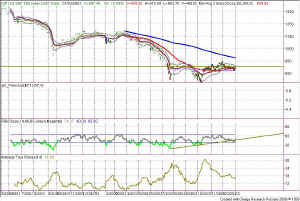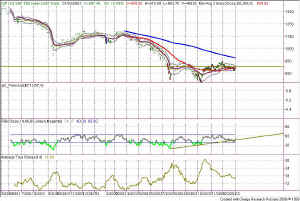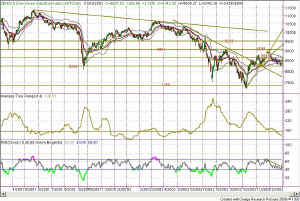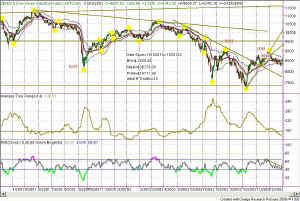NAVIGATION:
| How to use our commentary |
| FAQ |
| Member sign in |
| Free week guest |
| I want to read about the benefits |
| View Daily Archives |
| View Weekly Archives |

"The Sunny Side of the Street"
THURSDAY NIGHT--January 2, 2003
Figure 2 - Enlarged view of the averages
RSI on the S&P chart has dipped below the trendline that was supporting the lows, although it is still in a nice pattern, staying off of the 40 line. Price -- and this is important -- is staying right on the 50-day moving average, though it is not yet to the 200-day moving average. We've done nothing but meander sideways as the 200-day mav continues to drop downward. As you know from reading my other commentaries, the 200-day MAV is an Attractor, and prices will revert to the mean. Now, whether price gets above that Attractor at the 200 day MAV or not is another story yet to be told.
Price on the S&P is also sitting squarely on my Dynamic Moving Average and refusing to budge, while the ATR (Average True Range) drifts on downward, calling for an imminent large move in one direction or another. I would say that today's 265 point up move in the Dow would so qualify. It bounced us right off the Dow Attractor where it was sitting at 8226 (Figure 3) and nearly to the next Attractor at 8645.
If we read the Elliott Waves starting with 0 at 10/10/2002, and the top of the 1 wave being at 8931 on 11/28/2002, then by my E-calculator the 2-wave could correct down to 8250 and the 3-wave could go on up to 10,991. I don't have the feeling that the market is yet ready to take a nice, strong Elliott Wave move like that just yet. But, wouldn't it be wonderful? A sharply measured spring like that would bring back in all the buyers, thinking a new bull market was at hand. I don't think we are ready for that yet. From my perspective, we are in for at least 2 more years of this range trading tedium as we eventually make another stab at the 10,500 area of resistance.
It was like this in the 60's and 70's (when I first got interested in the stock market), as we plowed back and forth between 591 and 1000 for 4.5 years before breaking 1000.
Still, there is plenty of room for trading, just of a different type than we have become accustomed to over the 1982 (when we broke above 1000) to January 2000, when we ended "the biggest bull run in history."
The only thing you can do is listen to the market. When it's momentum and ADX are moving sharply upward, we buy; when the ADX is moving sharply upward and the momentum and moving averages are moving down, we go short; in all other times we range-trade, or sit on the sidelines.
This is when I use my PHW indicator--to see if there is any money to be made in a particular instrument (aka symbol, vehicle, stock, ...). In Figure 4 you can see the big yellow dots strategically placed at the ideal highs and lows.
Figure 4 -- PHW Ideals on the Dow
These dots were placed automatically by my PHW TradeStation indicator. Notice also, when you double-click to enlarge the chart, that right in the middle is a legend of important information, calculated and written by the indicator itself.
The first thing I want you to notice is the date span: from 1010207 to 1030203 is approximately 2 years. Over those 2 years a buy-and-hold strategy would have netted us the BH figure of -$2029.28. Forget the buy-and-hold philosophy. The next figure, called Ideal, shows how much money you could have made trading one share of the Dow if you could have gone long at each low dot and gone short at each high dot, constantly reversing your positions. That figure is called "Ideal" and means that you could not have made more than $36,779.80 in a perfect world, trading 1 share. PHW is 40% of the ideal. Over the years I have found experientially that this is about what it is possible to make, this or less--depending on your discipline. So, if we are really good traders, we could have made $14,711.90 per share during the past bear market by going long and short.
I also use this indicator to compare my actual trading to the perfect scenario. How close did I get to the dots? Am I buying low and selling high? Or, am I doing just the opposite? The PHW dots remind me of what I am supposed to be doing.
A stock (or fund, or commodity, or index) with a high PHW is one that can be traded long and short. An instrument with a low PHW is a buy and hold candidate. Now, finally, I come to the question a student asked me earlier today, how do I choose stocks to trade? I look for stocks with a high PHW (that means that have been volatile enough to have wide swings) and which are now in congesting -- not moving. Experience shows that a stock that usually moves, and is just now stagnant, will probably go back to its usual behavior. I put a long stop entry above the previous high (prior to the congestion) and wait for the market to take me in. It's pretty mindless, but in the long-run it pays off
TRADERS:
I am long the 15 minute chart of the QQQs, expecting a run to about 25.87 tomorrow.
INVESTORS:
I am still short the long-term (daily) model since 12/19/2002, but will exit that position if we get a closing value over the DMA midline.
So, as always, stay nimble, humble and take small losses and big wins.
![]() Don't miss
it--Sunny only gives a few trading seminars each
year. She calls them "Solving the Puzzle"
because she
puts all the pieces together into one cohesive plan for you to become a
better trader. Make it your business! View
the syllabus--she only takes 15 students. January 17-19, 2003.
AND..to match Larry Williams' offer, on Friday we will be trading real-time,
with real money. I will split the winnings with the
class, and if there are losses I'll keep them for myself. Just
think...the seminar could be free!
Don't miss
it--Sunny only gives a few trading seminars each
year. She calls them "Solving the Puzzle"
because she
puts all the pieces together into one cohesive plan for you to become a
better trader. Make it your business! View
the syllabus--she only takes 15 students. January 17-19, 2003.
AND..to match Larry Williams' offer, on Friday we will be trading real-time,
with real money. I will split the winnings with the
class, and if there are losses I'll keep them for myself. Just
think...the seminar could be free!
Weekly Stock Picks for the week beginning 12/15/2002:
(Last week's picks made a profit of $670. Click Here to view the picks for last week, in the Archives.)
| Symbol | Breakout | Stop Loss | Goal | Close if Triggered | Profit/Loss |
| TOTAL |
![]() AND... if you are a TradeStation user, you need to
attend "TradeStation Made Easy"
February 7-9, 2003. Sunny knows TradeStation and EasyLanguage
as only another Trader could, and the class is more engaging and jam
packed with useful information than any other class you can find, at any
price. Enroll
Now--she only takes 15 students. And, the same real-time
trading offer applies.
AND... if you are a TradeStation user, you need to
attend "TradeStation Made Easy"
February 7-9, 2003. Sunny knows TradeStation and EasyLanguage
as only another Trader could, and the class is more engaging and jam
packed with useful information than any other class you can find, at any
price. Enroll
Now--she only takes 15 students. And, the same real-time
trading offer applies.




